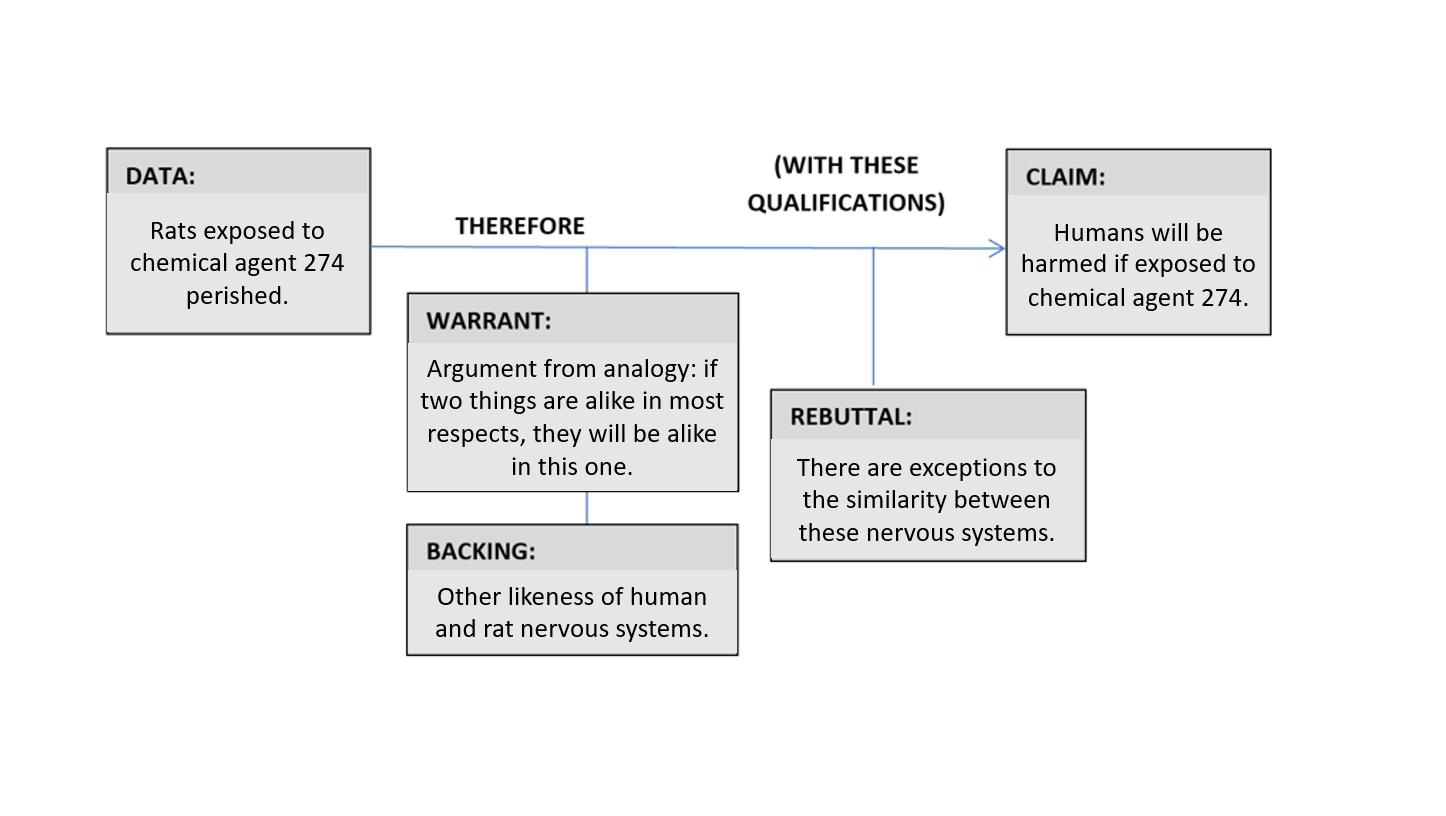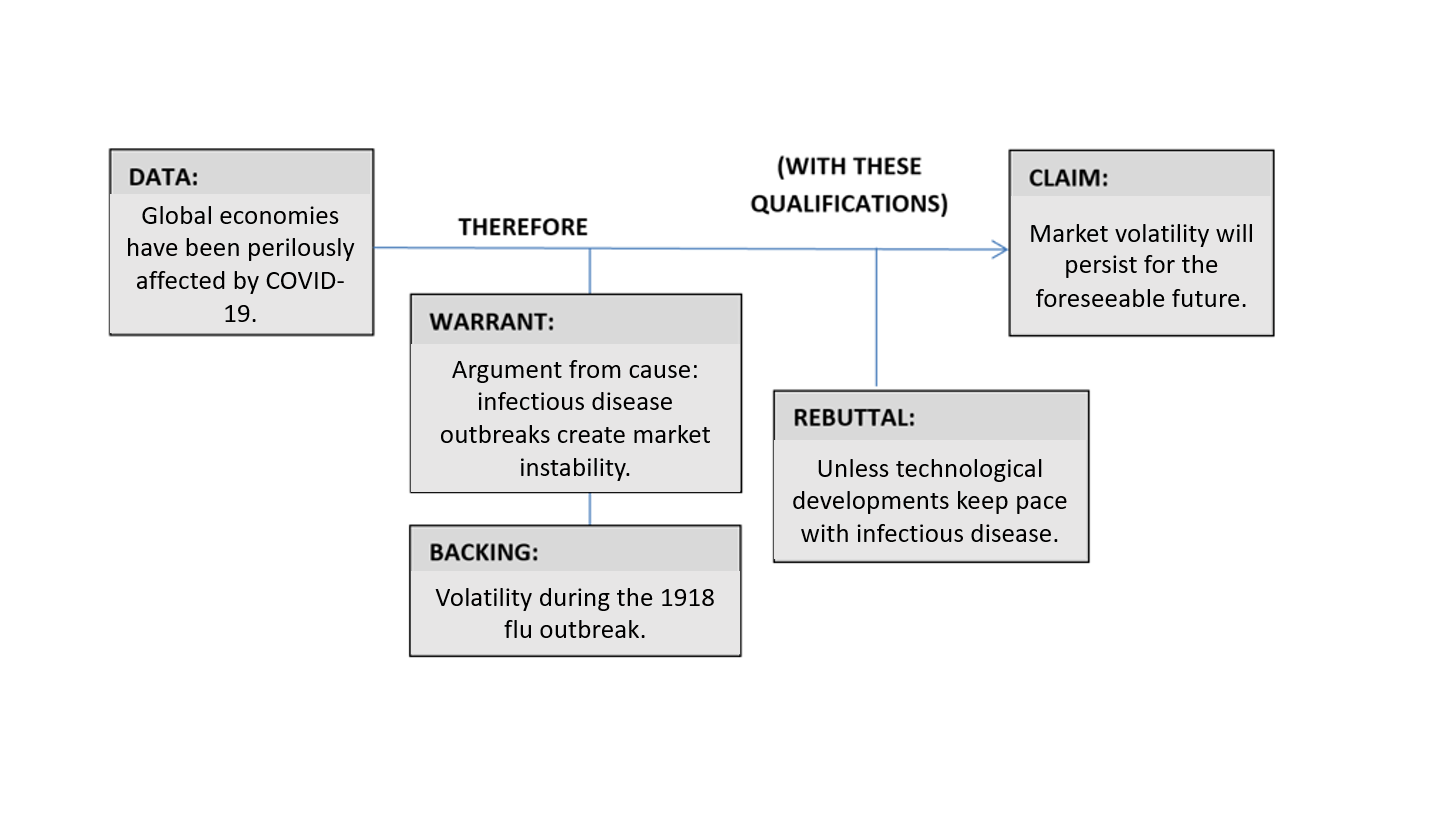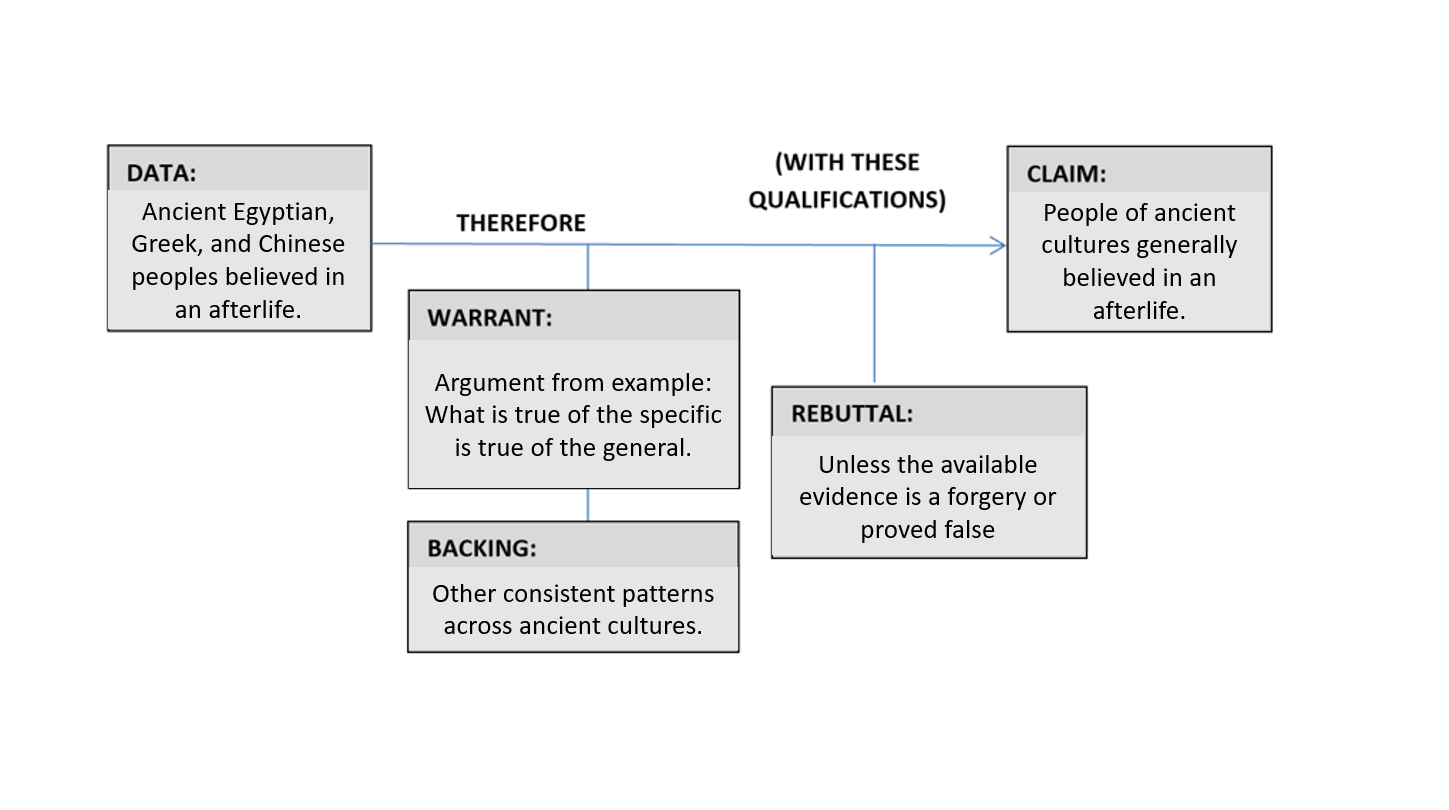Chapter 8: Rhetoric and Argumentation

This chapter is about rhetoric and argumentation and is divided into three sections. The first introduces key terminology related to “argumentation” including syllogism and enthymeme, Monroe’s Motivated Sequence, presumption and burden of proof, and audiences of argument. The second section introduces the Toulmin Model. Whereas the Toulmin Model focuses on the structure of individual claims, the third section of the chapter introduces the Logical Dependency model, which may be used to scaffold an entire speech or essay. This section also discusses fallacies or the characteristic errors of argumentative reasoning.
Watching the video clips embedded in the chapters may add to the projected “read time” listed in the headers. Please also note that the audio recording for this chapter covers the same tested content as is presented in the chapter below.
Chapter Recordings
- Part 1: Key Terms and Definitions (Video, ~15m)
- Part 2: The Toulmin Model (Video, ~20m)
- Part 3: Dependency and Fallacies(Video, ~20m)
Read this Next
- Palczewski, Catherine Helen, et al. “Chapter 4 Argument.” Rhetoric in Civic Life, Strata Pub., State College, PA, 2012, pp. 99–127.
Part 1: Key Terms and Definitions
This first section is about key terms for argument. This will include two definitions of argument and how they relate to the terms fact, value, and policy. It means we’re gonna be talking about structures of argument including the syllogism and the enthymeme as well as Alan Monroe’s motivated sequence. We’re gonna be talking also about presumption, the burden of proof, kinds of argument-audience, and spaces of argument. These describe the audiences for whom arguments circulate and the places or the locations where arguments may be found.
Defining Argument
In the above clip, Kelly Kapoor (played by Mindy Kaling) invents a distinction between two different kinds of argument: trash talk and smack talk. Trash talk is hypothetical and doesn’t describe a real-world situation. Smack talk is happening right now because the evidence is in front of us. The example resembles argumentation because a major way that arguments are built is by drawing divisions or distinctions. Generally, we should also think of argumentation as a practice of reason-giving in which a speaker provides reasons to support a given claim. We can also think of arguments in two additional ways: as things and as relationships.
Arguments as Things
When we talk about arguments as things, we’re talking about speech that we exchange between different participants in an argument. And one person presents a claim and then supports it with evidence to gain assent to the claim or to get other people to believe that the claim is true. We’ve already thought about arguments as things all the way back in Chapter 1. There, we drew upon Aristotle’s three rhetorical genres: forensic, epideictic, and deliberative.
- Fact-based claims are forensic because they are concerned with what is and isn’t the case, and prove the truth or falsehood of a claim. These are also known as arguments that fall within the forensic genre of rhetoric.
- Value-based claims are epideictic because they either praise or blame. These are also known as arguments that fall within the epideictic genre of rhetoric.
- Policy claims are deliberative because they are concerned with what we should or shouldn’t do as a course of future action. These are also known as arguments that fall within the deliberative genre of rhetoric.
When we talk about arguments as things, we’re talking about speech that we exchange with one another as well as discrete claims that we make about the true and the false (forensic), praise and blame (epideictic), and what we either should or should not pursue as a course of action (deliberative).
Arguments as Relationships
When we think about arguments as forms of interaction, we’re thinking about how people interact. Argument-based relationships are modulated by three factors: culture, ritual, and learning.
- A cultural context exercises a strong influence over the kinds of relationships created by argument. In some contexts, arguments are thought of as “heated disputes,” which leads people to avoid arguing at all costs. In others, arguments are a routine part of group interactions and are part of normal social behavior. Different cultural contexts for argument define different rules for when and how arguments can be made. Often, departing from one’s family or familiar home environment challenges these rules. A person who goes to a department store and attempts to negotiate the price of the items there may be more familiar with a cultural context in which arguments are part of buying and selling rituals.
- Rituals of argument may also define distinct kinds of relationships. Families, courts of law, and graduate school each create unique rituals around argument: whether or not to allow them, when to accept them, and how they should be made. Often, arguments are ritualistically made in self-defense or in support of candidates for jobs. The defining feature for such rituals is that arguments are made in a consistent way and that participating in them is part of defining oneself as a member of a larger group.
- Learning is a final way that relationships develop around arguments. One circumstance in which arguments are leveraged is an educational setting, in which people have the opportunity to test claims and arrive at well-thought-out conclusions. Whether through the classroom or the process of peer review, different arguers engage with one another in order to facilitate a greater common interest. When experts or authorities make arguments, we also learn how to make claims. When we see someone on television using an argument that connects rising atmospheric carbon dioxide levels to global warming, we may learn how to make similar claims. Using arguments and warrants makes them more available to others.
Syllogisms and Enthymeme
When we think about arguments as things, most often we are thinking of them as structures or organizations of information that allow us to convey an argument to someone else. The earliest forms or structures of argument that allow us to think of an argument as things are the syllogism and the enthymeme.
The syllogism is long-form logical reasoning. A way of reasoning that first developed in philosophy in which a statement is offered, a second statement is offered, and a conclusion is provided that is a permutation of these two statements. Syllogisms are statements in which a conclusion is inferred from the truth of two premises.
- Major premise: all pandas are mortal
- Minor premise: John is a Panda
- Conclusion: John is mortal.
Characteristically, with syllogisms all work is shown, you can see all of the steps taken. The enthymeme is a similar form of reason, but unlike the syllogism, some element is left out for the audience to fill-in. By leaving some part of the argument out, what this allows is rhetorical persuasion or the feeling that the audience is “in” in the act of logical reasoning. Instead, the audience’s inference supplies a missing premise, allowing persuasion to occur in the mind of the audience.
The 1990s ad Be Like Mike featured Michael Jordan for instance drinking copious amounts of Gatorade, followed by the sign “Be Like Mike” that aired at the very end. What the audience would fill in is the idea that drinking Gatorade would allow them to “be like Mike.”
For many watchers/listeners, the tri-tone jingle of this advertisement is instantly recognizable. The number they provide (like 867-5309) is embedded in the memory of MILLIONS and the company name functions like a punchline to the tune. This resembles the enthymeme because the audience is part of the persuasion. They participate in the message because they are “in” on the reasoning of the advertisement.
Alan Monroe’s Motivated Sequence
A related way of structuring arguments comes to us from Alan Monroe who in the 1950s developed a sequence of arguments that allowed salespeople to put their products on display in an easy and accessible manner. Monroe’s motivated sequence lives on today because we can see it in patterns of speech that appear on television advertisements. It has the following steps:
- Attention: A flashy opening, something that takes the audience by surprise or gets them to tune in.
- Need: Establish that the audience needs something or that something is lacking from their lives.
- Satisfaction: Satisfy the need with a product. Presumably, this consists in an explanation of how the product fills the need.
- Visualization: Allow the audience to see how their lives would be changed or different by acquiring the product.
- Call to action: Specific steps or instructions to take to acquire this new magical thing that was going to transform everything.
Here are two classic examples:
In the second ad, the late Billy Mays first gets our attention with his signature self-introduction. He then establishes a need: tough-to-clean stains. The solution that satisfies this need? Oxi-Clean, which cleans, brightens, and eliminates odors all at once. Mays then provides a range of visualizations to allow the viewer to envision how they would use this product. In conclusion, Mays provides the call to action: to purchase Oxi-Clean, presumably at an all-time low price. This sequence, the syllogism, and the enthymeme are arguments as things. They are discernable structures people have used to leverage claims, exchange capital, and gain others’ attention.
Presumption and the Burden of Proof
Presumption and the burden of proof describe distinct obligations or the responsibilities given to arguers who engage in a debate. In debates, arguers typically take on one of two roles: the affirmative (who proposes a policy) and a negative (who defends the status quo). Alternatively, in a forensic, courtroom setting, these arguers either take the role of the plaintiff (the accuser who brings forth a case) or the defendant (the accused who defends against this case). They are usually oppositional in nature and so they have different roles or different tasks that they have to fulfill.
The affirmative and the defendant share the characteristic of presumption. Presumption means that we should believe that a given set of facts or information is true unless proven otherwise. A defendant in a courtroom should have the presumption of innocence, which means that we would presume that what they say is true unless contravening evidence arises. Likewise, for the affirmative in a debate, there is often a presumption that their plan will work unless the negative proves otherwise.
The companion to presumption is the burden of proof, which traditionally belongs to the person in a debate who brings forth the charges: the plaintiff and the negative. The role of a negative in a policy case is to generate uncertainty about the affirmative, to prove that their case will not work as planned, or that their evidence rests on shaky ground. As the plaintiff in a court case, you would have the responsibility to offer reasons that would overcome the defendant’s presumption, thereby casting significant doubt upon it. However, not all burdens of proof are the same, as illustrated by this video on the distinction between criminal and civil courtroom trials:
Presumption and the burden of proof, therefore, describe two different roles and responsibilities given to the participants in the debate: one of them is the affirmative/defendant who is given presumption, and the other is the negative/plaintiff, who receives the burden of proof.
The Audiences of Argument
The audiences of an argument can be divided into two categories: the universal and the particular audience. These concepts answer the question: “to whom is an argument addressed”?
The universal audience is the audience of all reasoning, beings, and humanity. If everyone were presumed to be rational, capable of reasoning, then the universal audience would be the audience to whom this message was addressed. In other words, if we needed to get emergency information to COVID-19 out to the public, it would be addressed to a presumed universal audience: all people who are capable of reasoning or all people who are capable of taking in a message. Likewise, when we dispose of nuclear waste, it has become a problem for scientists to develop messaging that wouldn’t just last for ten years or twenty years, but hundreds or thousands of years into the future. Making them imagine a universal audience for whom a single message would still be intelligible. The question is, what would it take to communicate with all of humanity? How would it be possible to create a message that would be available to literally everyone?
The particular audience is the actual audience we engage in the real world. Particular audiences are varied and have their own dispositions, judgments, values, attitudes, opinions, rituals, and traditions. Particular audiences remind us that it is not possible to just send one message to all people and expect the same response or reasoning. Particular audiences require arguers to tailor their messages. Just as you would not send one letter to every potential future employer, a particular audience is a “someone” rather than an “everyone,” they must be addressed with a message specifically for them, rather than with one message that you’re sending out to the public.
Spheres of Argument
The spheres of argument describe the places where it is that arguments can be found. From smallest to largest, the personal, the technical, and then the public are the places where these arguments circulate.
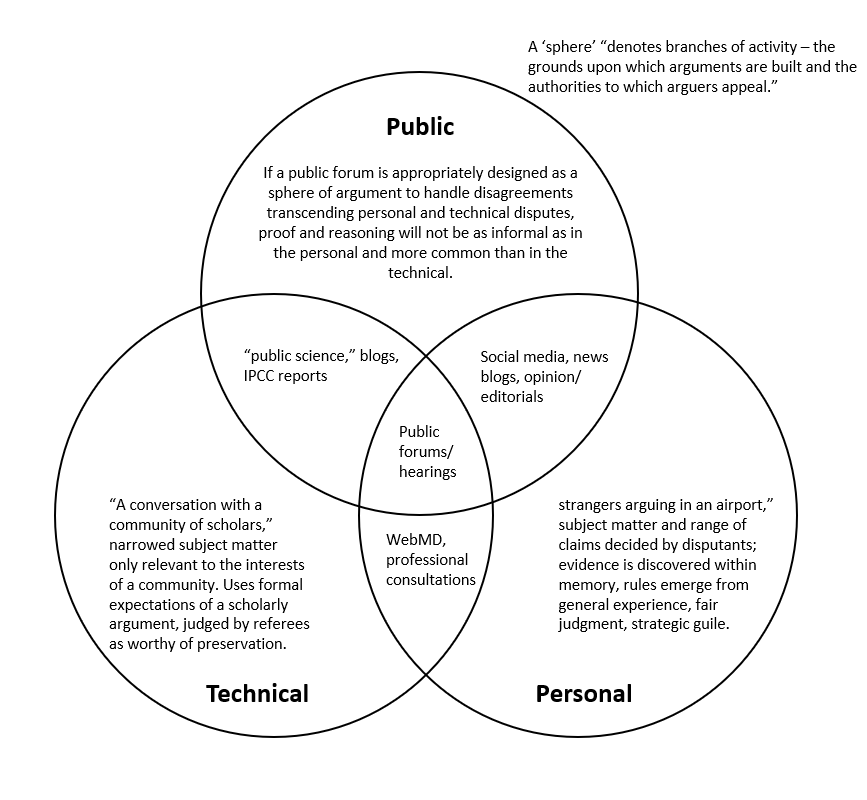
- The personal sphere is the place of limited circulation and informal reasoning. Meaning people aren’t using syllogisms, they are using enthymemes more often than not, and the arguments that are made are intuitive to the people that belong to that personal sphere. The participants are ley participants, are non-experts, and so the concerns of this community largely regard the members of that community. It is the place where the most informal arguments occur among a small number of people, involving limited demands of proof, and are often about private topics.
- The technical sphere, by contrast, has expert participants who use formal reasoning and the participants in this sphere can vet each other’s arguments because they all belong to the same shared community. However, like the personal sphere, the arguments that circulate in this sphere have limited circulation. It is an argument sphere that has explicit rules for argument and is judged by those with specific expertise in the subject.
- Finally, the public sphere is the largest or widest sphere of argument circulation. In terms of the other terms we’ve just discussed, it is most like the universal audience. It is the argument sphere that exists to handle disagreements transcending personal and technical disputes. When arguments escape the personal sphere or escape the technical sphere, they go into the public sphere where they can be interpreted, misinterpreted, and negotiated. Twitter is a good (albeit small) example of a public sphere because of the way that personal disputes or technical information can escape and then become part of a larger discussion (although, of course, that doesn’t always happen and sometimes arguments also stay in their respective spheres).
Part 2: The Toulmin Model
The Toulmin Model has several specific features:
- First, it imagines arguments as objects of verbal exchange. This places it into the category of arguments as things, discussed in the previous lecture—or as objects that are transacted between arguers.
- Second, the Toulmin Model is useful for individual claims that you would set out to prove in a paragraph or less. When thinking about how to apply the Toulmin Model to your own writing, this would be a way of organizing individual paragraphs or sentences, rather than a way of thinking about how to build out the structure of an essay as a whole. (We’ll talk more about how essay argument scaffolding is better understood in terms of the logical dependency model in the next major section).
- Finally, the Toulmin Model is a way to diagnose the strengths and weaknesses of individual arguments. For example, if the evidence is not sufficient in a given argument or if the reasoning is not strong, the Toulmin Model points to these elements as specific ways to address the weakness of arguments.
The Toulmin Model has six components. The primary elements are the claim, the data (or evidence) and the warrant (or reasoning). A claim is a contestable statement based on the data/evidence. The warrant is the logical connection between the data and the claim. The secondary elements are the qualifier, the rebuttal, and the backing. The qualifier softens the claim by making it conditional. The rebuttal offers likely counterarguments to the major claim. And the backing is evidence that the warrant is itself sound. The images below shows the full Toulmin Model, including all six of its separate elements, as well as an example drawn from Colin Powell’s 2003 speech to the United Nations.
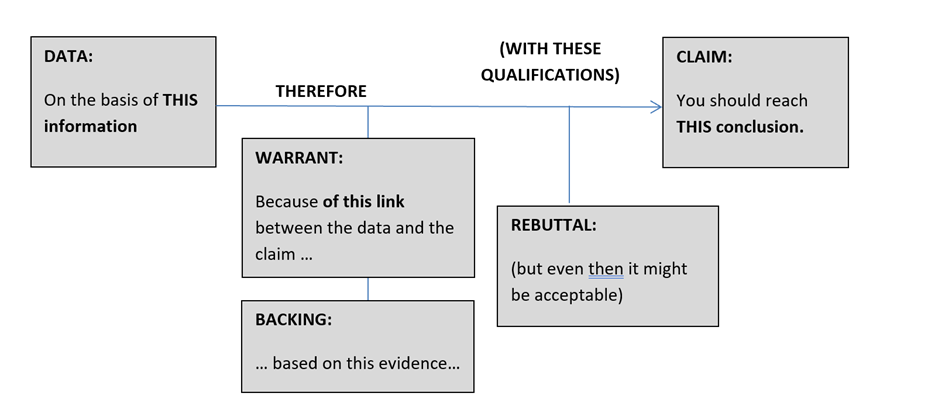
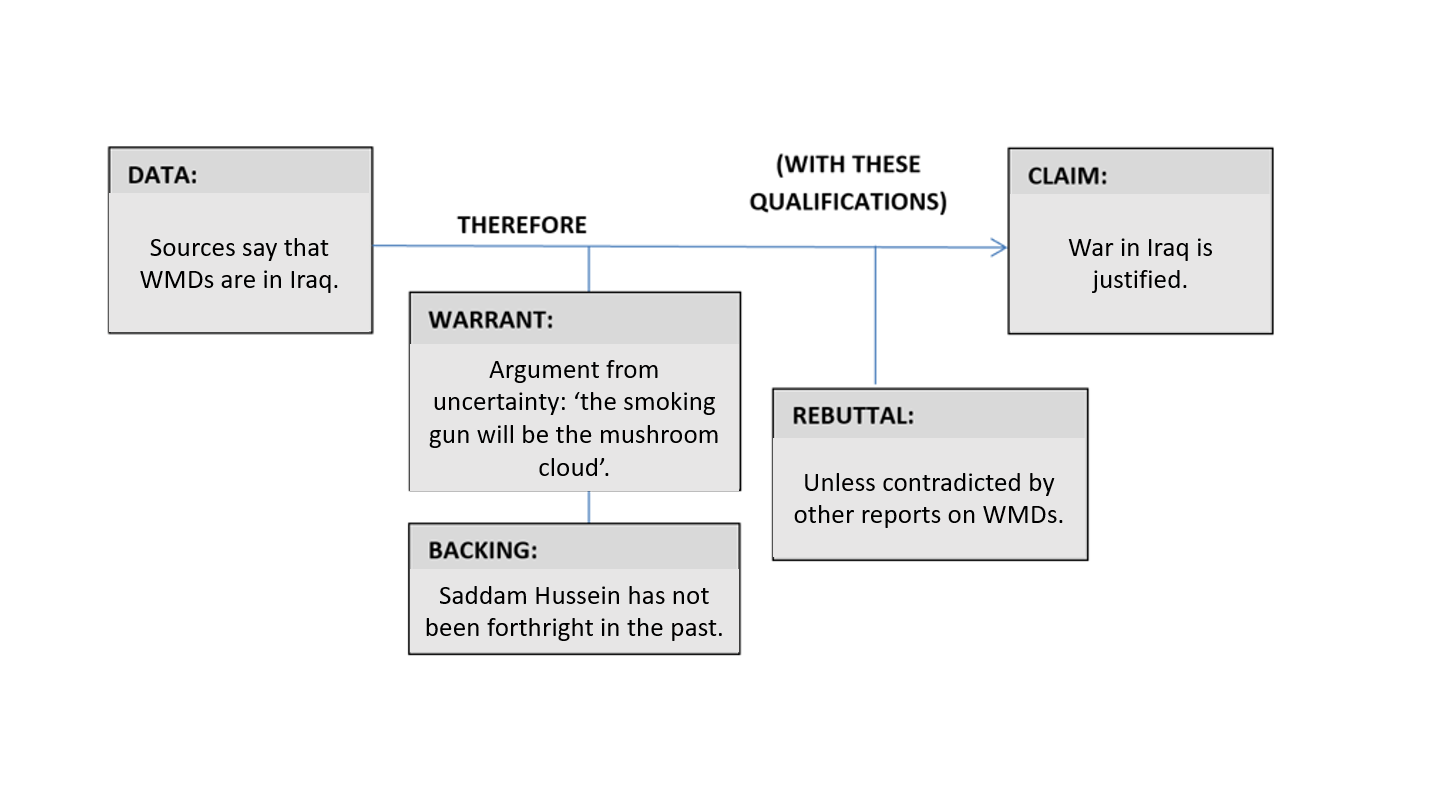
Data, Claim, Warrant
The most fundamental part of the Toulmin Model is the warrant, the data, and the claim. All claims require data. The previous section discussed three kinds of claims: fact, value, and policy. The three parts of the Toulmin Model may be phrased in the following way: on the basis of this information (the data), you should reach this conclusion (the claim) if you use this logical reasoning or connection (the warrant). For example:
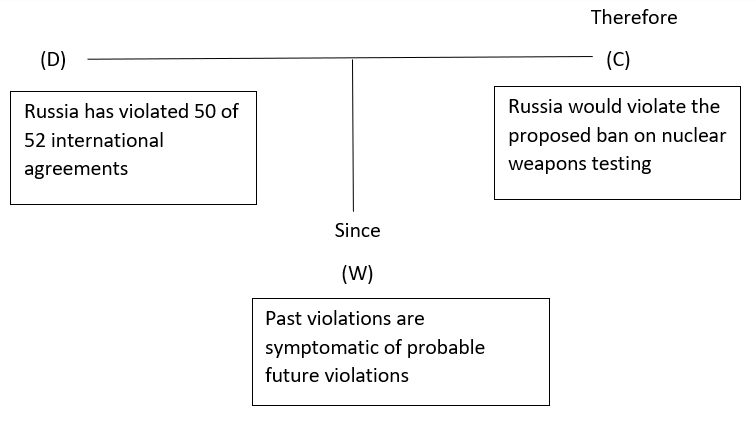
This claim is connected to data by way of a logical warrant. In this case, the data or the evidence is that Russia has violated fifty of fifty-two international agreements. Because of this information, we should conclude that Russia would violate a proposed ban on nuclear weapons testing that we are considering right now. The connection between these two elements is the following warrant; that the past is a predictor of the future. Since past violations are symptomatic of probable future violations, we can assume that the claim is true. All of these elements taken together would read in the following way:
On the basis of the information that Russia has violated fifty of fifty-two existing international agreements, we should conclude that Russia would violate the proposed ban on nuclear weapons testing. We should reach this conclusion using the reasoning that past violations are symptomatic of probable future violations.
In the real world, it’s important to note that warrants often go unstated. They’re usually assumed, or the logical connection between the data and the claim simply is not set out correctly.
Backing, Qualifier, Rebuttal
The secondary elements of the Toulmin Model are the backing, the qualifier, and the rebuttal.
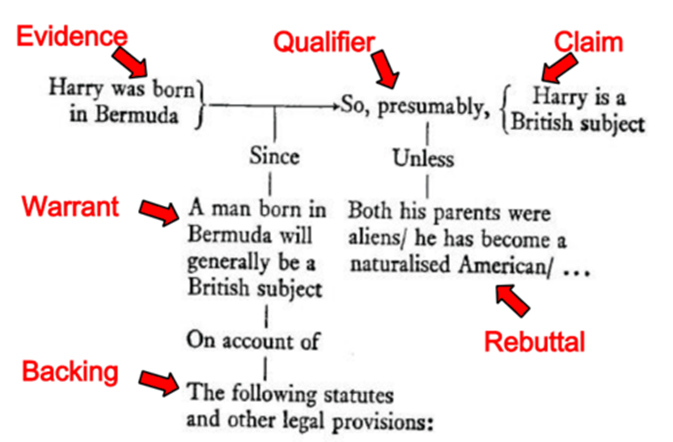
- The backing refers to the support for the warrant. It describes the assurance that the warrant is authoritative or current. We can know for instance that the past isn’t just true for Russian treaty agreements, it’s true under other circumstances as well.
- The qualifier is a statement that reduces the strength of the claim. It indicates the strength conferred by the warrant, and claims can be qualified with terms like usually, possibly, likely, in all probability, presumably, and always. The qualifier specifically reduces the strength of the claim that we’ve been considering by making it conditional or probabilistic.
- The rebuttal is a counterargument that invalidates the claim. This counterargument might be certain circumstances in which the general authority of a warrant should be set aside. If for instance, there has never been a historical precedent for what we’re up against today, the past might not be a good predictor of the future.
If we think about all of these different elements working together, using the example through the previous slide, it might look something like this.
On the basis of the evidence that Russia has violated fifty out of fifty-two of its past agreements, we should conclude it would violate the treaty that is in front of it right now. This is good reasoning because we know the past is a good predictor of the future. We know that the past is the predictor of the future because there are many other instances of history repeating itself. Of course, it is possible that Russia might not violate the treaty, but if so, this would only be the third time that Russia would have complied with an international agreement.
Because Harry was born in Bermuda, we can conclude that Harry is a British subject, since a person born in Bermuda will generally be a British subject. Moreover, we can know that a person born in Bermuda will generally be a British subject on account of existing statutes and other legal provisions. So presumably, Harry is a British subject, unless, of course, both his parents were aliens or he has become a naturalized American.
Next, let’s consider warrants more closely. There are many kinds. Warrants are the connection between a data and a claim, between evidence and the argument that we’re making.
Deductive reasoning argues from general or well-accepted premises to concrete cases. The syllogism, discussed in an earlier section of this chapter, is an example of deductive reasoning because it begins with a major premise that is presumed to be generally true. It then leverages a hypothesis (the minor premise) to reach a conclusion. Although deduction is often associated with the scientific method of hypothesis-testing, deductive reasoning need not begin from a science-based major premise. To engage in deductive reasoning, one may start from a major premise based in fact, value, or law to make a claim about a particular, as-yet unexplained case. Deduction, in a nutshell, argues from what is already understood to be true or factual and moves from this true statement to a particular circumstance in which the truth of that major premise may be evaluated and refined. When we talk about deductive warrants, we are describing a logical move of argumentation that takes us from something well established to a particular circumstance that supports the truth of this well established claim.
- Major Premise: Gravity acts upon all bodies with mass.
- Minor Premise: Photons (light) do not have mass.
- Conclusion: Gravity does not act upon photons (light).

Ultimately, the deductive conclusion provided above is not completely correct. Gravity does have an effect upon light, although this is not because light has mass! This has led to a refinement of the major premise: Because light has no mass, gravity does not affect light directly. instead, gravity affects the space-time through which photons travel. This results in the ‘warping’ or ‘bending’ of light through space, even though gravity does not act upon photons themselves.
Inductive reasoning argues from specific cases to general conclusions. When you’re faced with a situation in which you have knowledge or information about a specific number of cases, but you lack an understanding of the “global” or “overaching” factors that might unite those cases, inductive reasoning is what allows you to make that leap. If deductive reasoning is “top down” (from the most general to the most specific) then inductive reasoning is “bottom up” (from the most specific to the most general). If you live someplace with a view of the street and you see that 8/10 people walking on the street are wearing facemasks, inductive reasoning would allow you to reach the conclusion that mask compliance in your town is approximately 80%. Inductive reasoning would allow you to reach that conclusion, even if it is note entirely reliable (unless, of course, you live in a very small town).
This kind of causal logic is a causal generalization. This example is about medical care at the university. It is a well-accepted premise that reducing the choice of medication for generic brands will create negative health outcomes, and so here at this particular university, a transition to a health plan with less coverage will negatively impact graduate students on campus. Because we widely know that the transition of generic drugs has negative health outcomes, in this particular circumstance at this university, we can infer that the same cause-effect relationship would hold in place, making this a deductive cause. As causal correlation, the logic of cause can be inductive, showing from a specific case how a more general consequence will follow, and as a deductive case, showing how a general pattern of cause and effect will show up in local or particular circumstances.

I’d like to talk very briefly about the relationship between signs and causes as different kinds of warrants and to distinguish them from one another a little bit more closely. Signs and causes are easy to confuse, they fall often into the same sort of category, and they do differ depending on the kind of evidence that is being brought to bear on a given claim. On the exam, you can expect to see a question that provides data, claim, and a warrant, and you’ll be asked to identify what the warrant is. And so, a sign is the logic that where there’s smoke, there’s fire. How do we know that there’s a problem there? What is the sign, what is the symptom that is out there that shows us that a problem exists? When we’re talking about causes, we’re talking about the origin of the problem. Where did it start from, where it began. And so if our claim is about dinosaur extinction, we could say that, on the one hand, a very big asteroid caused an enormous shock, that created their extinction, or on the other hand, we could say that we know that the dinosaurs went extinct, because we have geological evidence from the crater impact zone, which is like the smoke from the fire, the thing that reminds us of what happened there, as opposed to the thing that happened. If our claim was about the ballooning national deficit, the thing that caused that deficit is multiple increases in the national debt ceiling. Whereas the sign of a ballooning national deficit is lower bond returns and a widening gap between the lower and middle class. Again, these are symptoms, rather than the cause of the looming national deficit.
If we’re talking about how the cause of a specific pandemic disease is ultimately a virus, a fungus, or a bacteria that has not been contained, but we know that it’s out there, we know that there’s smoke that is showing us that it’s out there, that, based on population levels, and symptoms of illness.
Inductive Warrants: Example, Analogy, and Causal Correlation
Two kinds of inductive warrants include example and analogy.
Examples are inductive warrants in which what is true of the specific is true of the general.
For instance, consider the claim “the people of ancient cultures believed in an afterlife.” The data is that the Egyptians believed in an afterlife, which is shown by their funeral preparations. Plato’s writings also indicate that the ancient Greeks believed in an afterlife. And so the connection between the general belief in an afterlife is supported by two pieces of data: the Egyptians and Plato. What is true of the specific is true of the general: two cases indicate that ancient peoples believed in an afterlife, so more generally, people of ancient cultures must have believed in it as well.
Analogies are inductive warrants in which if two things are alike in most respects, they will be alike in a general sense.
Consider the following claim: If exposed to Nerve Agent 274, then 90% of all humans will die because a similar proportion of rats died in experimental trials. The data for this claim is that rats are mammals and possess a nervous system that resembles a human’s in most respects. The relationship between the claim about humans potentially dying from this nerve agent, and the evidence, (a comparison between rats and humans) is that if these two things are alike in most respects, they will be alike in this respect. And thus, it forms a connective logic that takes specific cases and draws a general conclusion.
Causal correlations are inductive warrants in which “if an increase in X leads to an increase in Y, then a decrease in X should lead to a decrease in Y.”
For instance, if an increasing in indoor masking and vaccination leads to an increase in the number of people who have natural immunity to a given infectious disease, then causal correlation would tell us that a decrease in indoor masking and vaccination status would lead to a decrease in this same immunity. Correspondingly, if an increase in atmospheric carbon dioxide levels leads to higher global temperatures, then a decrease in atmospheric carbon dioxide would lead to a decrease in global temperatures. The warrant from causal correlation is inductive because a particular link between X and Y allows us to reach a more general conclusion: namely, other related linkages between these two variables.
Deductive Warrants: Sign and Causal Generalization
Two kinds of deductive warrants include signs and causes.
Signs are deductive warrants where evidence is a verified general indicator of something beyond itself.
The logic of the sign resembles the “index” discussed in the chapter on “the symbol.” The claim that “where there’s smoke, there’s fire” relies on a sign: the smoke is a verified, general indicator of something beyond itself: fire. Similarly, economists long ago pointed to positive purchasing trends in low-cost food items (such as Kraft Macaroni and Cheese) as a sign of imminent economic downturn. Mass purchases of Mac n’ Cheese indicate something beyond the evidence: that a recession is on the horizon. A final example is if your instructor comes into class flustered, it may signal that they are underprepared for class. It may or may not be true – your instructors may be having a difficult day due to family, job, or health problems – but the logical conclusion is deductive because you, as an observer, are making a claim based on what you perceive to be general indicators.
Causal Generalizations are deductive warrants when, given a recognizable cause, we can infer a particular effect or consequence.
When it is deductive, this kind of causal logic is called a causal generalization. For instance, rising atmospheric carbon dioxide levels are a clear cause of the “greenhouse effect,” which leads to global warming. Because carbon dioxide levels verifiably lead to this consequence, we can make the causal generalization that an observable increase in these gasses will yield a predictable result.
Another example of causal generalizations might be about medical care at the university. It is a well accepted premise that narrowing the availability of generic brand medication causes greater negative health outcomes. At our particular university, a transition to a health plan with less coverage of generic brands will negatively impact the health of students on campus. Because this cause-effect relationship is verifiable and generally true, it would make it true att our university, making it a deductive causal generalization.
Separating Signs from Causes
It is easy to confuse signs with causal generalizations, although they are different kinds of warrants. Ultimately, the deductive logic of the sign is asking about a confirmed symptom: “where there is smoke (the symptom) there is fire (the disease). The deductive logic of causal generalization refers to an origin: where did a given thing-in-the-world start or begin? Let’s consider a few examples:
Let’s say that we are considering a claim about dinosaur extinction.
- A causal generalization might argue that a very big asteroid was the origin of a catastrophic global shock that resulted in extinction. Because we know that A (the asteroid) causes B (global extinction events) we can say that this cause resulted in that effect for the dinosaurs.
- A sign might point to geological evidence from the crater impact zone that indicates an inhabitable environment for oxygen-breathing creatures, such as residues of ancient carbon monoxide. Because we know that this sign (carbon signatures) are an indicator of something beyond itself (an unbreathable environment) we can say that this evidence points to the reason megafauna no longer walk the earth.
Another way to separate signs from causes is to consider the ballooning national deficit.
- A causal generalization might point to repeated increases in the national debt ceiling, which is the literal, most immediate ’cause’ of this debt.
- A sign-based argument might point to lower bond returns and a widening gap between the lower and middle class as indicators that debt has gotten out of control.
A third example is pandemic diseases.
- There are limited general causes for a pandemic disease: a virus, a fungus, or a bacteria.
- The signs of a pandemic disease are literal symptoms as well as changes in employment, hospitalization, and mortality rates.
Finally, let’s consider different warrants related to becoming internet-famous.
- We might say that the general cause of that internet fame is that you had a very viral post, and then someone confirmed or with many followers retweeted you, and then that spiraled out of control.
- The sign that you’re internet famous might be that people you don’t know on campus come up to you, tweet at you, or start talking to you out of the blue.
The difference between sign and causal generalization is the difference between symptoms and origins. A sign points to an indicator of the claim that you’re trying to make, whereas a causal generalization points to a cause-effect relationship.
Complicating Toulmin, Anticipating Rebuttals
Ultimately, the Toulmin Model is useful not just because it lets us map our arguments, but because it helps us to anticipate how others will respond to our claims based on the intrinsic weakness of an argument. Recall, arguments are designed to be contestable even though they often begin from well-established or proven grounds. As indicated in the diagram below, there are a number of standard ways to respond to a given claim:
- A claim may be either too extreme or unclear.
- A warrant may make too big of a leap, it may lack backing, or it may just be the wrong warrant for the kind of claim being made.
- Evidence may not have been collected correctly, there may be too much evidence to reach a good conclusion, or there may be too little evidence to support the claim.
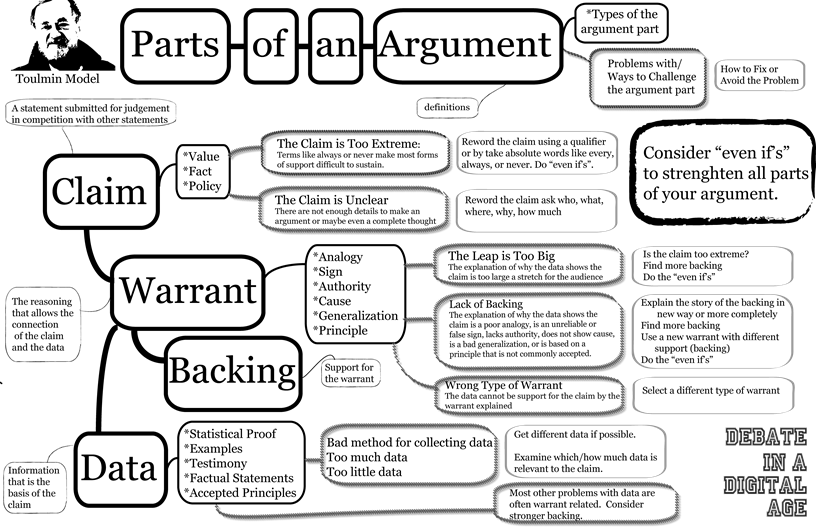
Clearly, this can get complicated. The point is that the Toulmin Model is a way to diagnose and strengthen your individual arguments, to anticipate what others will find wrong with them, and how to respond before someone raises an objection.
Part 3: Logical Dependency and Fallacies
This final section is about large-scale structures of argument that span the length f an entire book or essay. These include the logically independent and dependent structures. The last section of this essay is about bad arguments and fallacies and how to diagnose when arguments go wrong.
The Dependency Model is an alternative to the Toulmin Model. Dependency establishes two kinds of relationship between the thesis and the sub-claims of a speech or an essay. Whereas the Toulmin Model posits the warrant as the connection between a claim and it’s evidence, the logical Dependency Model posits two kinds of connection between a thesis and supporting claims. Like the Toulmin Model, logical dependency offers a way to diagnose the strengths and weaknesses of an argument based on its overall structure, or how the different arguments are linked together.
Logically Dependent and Independent Arguments
The two kinds of dependency are logically dependent and logically independent. The dependency structures can be imagined as a circuit because they arrange claims either in a series (dependent) or in parallel (independent):
| Logically Dependent | Logically Independent |
| Thesis: A condensed syllogism. | Thesis: A is a general category with subcategories BCD |
| A = D Koalas are a dangerous species. | A: Koalas are a dangerous species |
| A = B Koalas thrive on eucalyptus | B: Koalas eat their young |
| B = C Eucalyptus is invasive and the Koala population can grow a lot. | C: Koalas wage war on other marsupials |
| C = D Koala overpopulation is dangerous for the larger ecosystem. | D: Koalas are carriers of disease |
The logically dependent argument begins next to the plus or minuses: the thesis or “source”. It then moves from argument to argument, one building after the other, toward the conclusion. The thesis in a logically dependent structure is a condensed version of the entire argument as it unfolds from paragraph to paragraph. If one of the “lights” (supporting arguments) along the circuit fails, then the entire circuit (the thesis/total argument) ceases to function.
In the logically dependent example provided above, the thesis is that “koalas are a dangerous species.” To arrive at this conclusion, we have to go through a series of steps: First, koalas thrive on eucalyptus; second, because eucalyptus is an invasive species of plant, it can lead to koala overpopulation; and finally, koala overpopulation spells danger for a larger ecosystem. However, if one of the claims is proven false (e.g. eucalyptus is NOT an invasive species) then the entire argument fails.
In the logically independent model the thesis still starts at the source, but then offers three separate criteria or pieces of evidence that support the original claim. The thesis statement is like an umbrella. When we look at it as a drawn out argument, the thesis is a general claim that can be supported by any number of sub-claims that are separate (independent) from it. If one of the “lights” (supporting claims) along the circuit fails, the others may still function.
In the logically independent example provided above, there are three separate independent reasons that support the claim that koalas are dangerous. Unlike the dependent structure, these supporting arguments do not ‘build’ upon one another; instead, they stand alone. The first supporting argument is that that koalas eat their young. The second is that koalas wage war on other marsupials. Finally, koalas are carriers of disease. Each offers a different rationale for why koalas pose a real danger. However, if one of the arguments is invalidated (e.g. koalas clearly cannot ‘wage war’) the other two supporting claims may still stand.
When it comes to writing an essay, the structure of logical dependency can help you to scaffold arguments at the level of the topic sentence. A thesis should appear in the first paragraph of your essays, laying out your major claim as well as the purpose and overall structure of the paper. Each paragraph can then be organized in either a dependent or independent manner, building one claim atop another from paragraph to paragraph or, alternatively, providing separate reasons why the thesis should be supported.
| Logically Dependent | Logically Independent |
| Strengths: Allows the arguer to go “in depth” on a claim by providing a stage-by-stage account of its validity. | Strengths: Allows the arguer offer “breadth” about a claim by providing a number of separate reasons why it is to be accepted. |
| Weaknesses: If any one ‘stage’ of the argument is falsified or invalidated, the entire argument may be dismissed. | Weaknesses: No one of these sub-claims is fully developed or goes beyond a surface treatment. |
Both structures have unique strengths and weaknesses. The strength of the logically dependent series is that it allows the arguer to go into depth with a single claim, by providing a stage-by-stage account of its validity. However the logically dependent series also has a key weakness. If any one stage or piece of the argument is falsified or invalidated, the entire argument may be dismissed.
The most defensible claims use a hybrid structure: one that uses both dependent and independent forms of argument. To return to an example from earlier in this chapter, Colin Powell’s argument to the UN was organized as a hybrid dependent/independent structure:
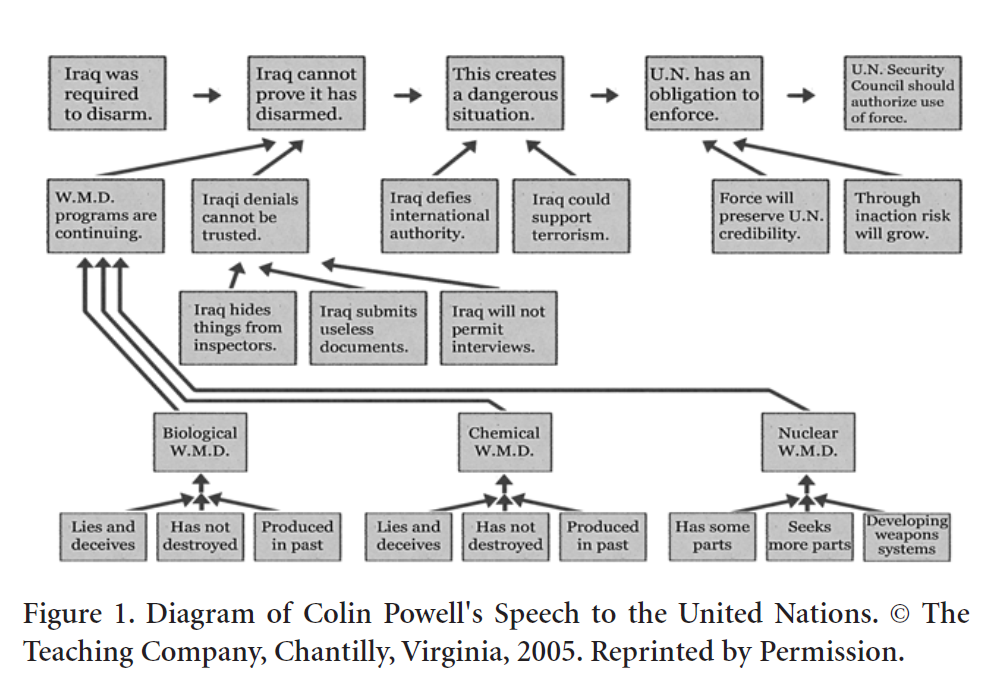
The major claim that runs across the top of this page is dependent. Each part builds one part atop another, and each ‘step’ is required for the ultimate claim (the UN Security Council should authorize the use of force). If one of these top-level claims is invalidated, then the whole argument falls apart.
The substructure below this top line is independent. There are a series of separable reasons provided for each claim as a redundancy measure for the dependent claim. For example: the second “step” (“Iraq cannot prove it has disarmed”) is supported by two independent supporting claims: (“Weapons of Mass Destruction [WMD] programs are continuing” and “Iraqi denials cannot be trusted”). These claims, in turn, are backed by their own supporting claims (We can know that WMD programs are continuing in the areas of “biological,” “chemical,” and “nuclear” weapons creation).
It is important to note that just because a claim is complex does not mean it is true. Ultimately, Powell was incorrect about the stockpiling of WMDs in Iraq: investigators found no evidence that this was ever occurring. Additionally, the UN Security Council did not find Powell’s claims compelling because they were based on uncertainties about Iraq rather than obvious evidence. In the end, even Powell said that his speech was “a great intelligence failure” based on unsupported evidence and inadequate sourcing.
Fallacies of Reason
Next, we are going to talk about logical fallacies. Once again, please remember that all the powerpoints displayed in this lecture are available on canvas if you experience poor video quality. There are several videos in this next section. The first thing that I want to show you here is the ad hominem fallacy, one of the most common fallacies that we know of. This video will explain not only what it is, but also sub variants and sub categories of the ad hominem fallacy.
Beyond the ad hominem, fallacies are generally incorrect forms of reasoning. Typically, when someone uses a fallacies, it is grounds to call them out for using a bad warrant, or incorrectly making a connection between claims and evidence.
There are many fallacies of reason. Here are few common variations:
- The argument ad hominem, which we just explored, is an attack on the person rather than engagement with the argument. It’s a deflection from the claim by talking about the character of the people who are making the claims.
- The argument ad populum employ the bandwagon fallacy. It establishes that if a majority of people are doing something, we should do it too.
- The straw man argument is a reduction of an opposing argument. It takes issue with a very narrow or specific piece of someone’s argument and then blows it up as if it is the entire argument that the person is making. So by reducing the position to a non-representative claim or to a single sentence or single word in an arguer’s argument, the straw man fallacy allows the arguer to take up a position of strength by making an over claim about what the opponent is actually saying.
- The slippery slope fallacy is a way of connecting evidence through an unbacked causal chain. A leads to B leads to C leads to D, but the connection between these points is assumed rather than proven. Because the causal chain is very weak, one thing rests upon another thing, rests upon another thing, rests upon another thing so that ultimately it leads to some devastating consequence.
- The non-sequiter fallacy is one in which the claim does not follow from the evidence. Non-sequiter literally means “does not follow,” in which the connection between an argument and its data is absurd, satirical, or nonsensical.
- The false dilemma is an option of A or B. It forces a choice between two options as though there is no option except for these two. In fact, there may be a third or a fourth option. Here is an example of the false dilemma in action:
Fallacies are arguments that are made in a way that makes us want to believe them, but at the same time, use shortcuts or use connections between evidence that are inappropriate or not as rigorous as they should be. But even though we can see arguments as bad in this way, they are more and more common. This is especially in advertisements, which use fallacies as a recognizable form of reason, thereby allowing the audience to be part of the persuasion.
The Non-Sequiter
This Doritos ad employs the non-sequitur because it descends into absurdity when demonstrating the lengths to which people will go for their chips.
The Slippery Slope
In this case, the viewing audience can identify with the reasoning, even as we recognize that it is flawed. The slippery slope allows one thing to lead to another and another until “you” end up with an eye patch. As a technique for advertising, we are all in on the joke. The commercial doesn’t try to sell us on the product as much as it tries to create a shared experience of absurdity for the seller and the viewer.
The point here is that advertisements in general allow us to identify with bad reasoning. Fallacies are indeed flawed arguments, but insofar as they are common modes of reasoning, they can also allow us to connect with the message on the basis that we are all in the know. They are not just ways to dismiss incorrect claims; they are ways of leveraging claims that are recognizable to a wide audience.
Additional Resources
- Besel, Richard D. “Accommodating climate change science: James Hansen and the rhetorical/political emergence of global warming.” Science in Context 26.1 (2013): 137-152.
- Besel, Richard D. “Opening the “black box” of climate change science: Actor-network theory and rhetorical practice in scientific controversies.” Southern Communication Journal 76.2 (2011): 120-136.
- Bone, Jennifer Emerling. “When publics collide: Margaret Sanger’s argument for birth control and the rhetorical breakdown of barriers.” Women’s Studies in Communication 33.1 (2010): 16-33.
- Browne, Stephen H. “Rhetorical criticism and the challenges of bilateral argument.” Philosophy & rhetoric 40.1 (2007): 108-118.
- Carr, M. Kelly. “Amicus Briefs as Argumentative Scene in Bakke.”The rhetorical invention of diversity: Supreme Court opinions, public arguments, and affirmative action. MSU Press, 2018: 65-106.
- Eckstein, Justin. “Designing soundscapes for argumentation.” Philosophy & Rhetoric 51.3 (2018): 269-292.
- Endres, Danielle. “The rhetoric of nuclear colonialism: Rhetorical exclusion of American Indian arguments in the Yucca Mountain nuclear waste siting decision.” Communication and Critical/Cultural Studies 6.1 (2009): 39-60.
- Farrell, Thomas B. “Knowledge, consensus, and rhetorical theory.” Quarterly journal of Speech 62.1 (1976): 1-14.
- Greene, Ronald Walter, and Darrin Hicks. “Lost convictions: Debating both sides and the ethical self-fashioning of liberal citizens.” Cultural studies 19.1 (2005): 100-126.
- Goodnight, G. Thomas. “The personal, technical, and public spheres of argument: A speculative inquiry into the art of public deliberation.” The Journal of the American Forensic Association 18.4 (1982): 214-227.
- Goodnight, G. Thomas, and John Poulakos. “Conspiracy rhetoric: From pragmatism to fantasy in public discourse.” Western Journal of Speech Communication 45.4 (1981): 299-316.
- Goodnight, G. Thomas, and Sandy Green. “Rhetoric, risk, and markets: The dot-com bubble.” Quarterly journal of speech 96.2 (2010): 115-140.
- Goodnight, G. Thomas. “Gabrielle Giffords: A study in civil courage.” Rhetoric and Public Affairs 17.4 (2014): 679-710.
- Olson, Kathryn M., and G. Thomas Goodnight. “Entanglements of consumption, cruelty, privacy, and fashion: The social controversy over fur.” Quarterly Journal of Speech 80.3 (1994): 249-276.
- Jamieson, Kathleen Hall. “Justifying the war in Iraq: What the Bush administration’s uses of evidence reveal.” Rhetoric & Public Affairs 10.2 (2007): 249-273.
- Kelley-Romano, Stephanie. “Trust no one: The conspiracy genre on American television.” Southern Communication Journal 73.2 (2008): 105-121.
- Palczewski, Catherine Helen, et al. “Chapter 4 Argument.” Rhetoric in Civic Life, Strata Pub., State College, PA, 2012: 99–127.

